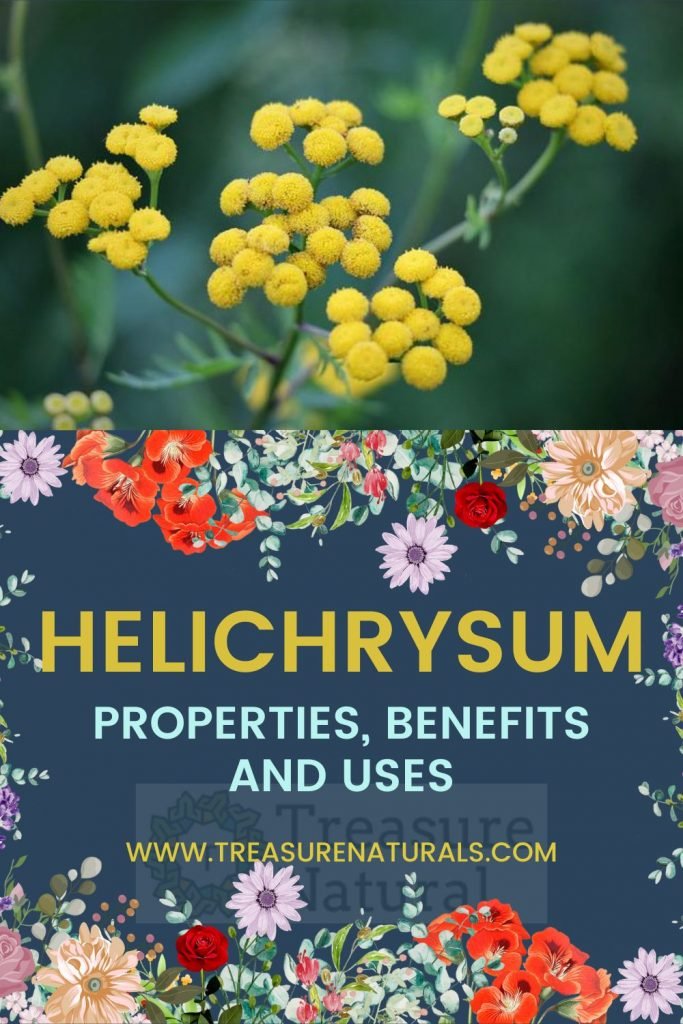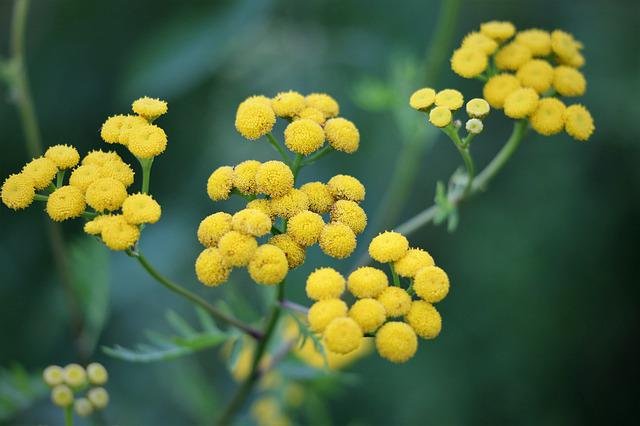
Let’s discover all the benefits and properties of helichrysum, a plant rich in essential oils, flavonoids and triterpenes that give it antihistamine, antibacterial and expectorant virtues.
The helichrysum plant
This plant has 500 varieties and blooms in midsummer, when its flower heads stand out in the fields for their yellow-gold color.
All varieties belong to the Asteraceae family and can be found in the plains, hills and up to 2000 meters high.
It is, in fact, a very common perennial plant in Southern Europe, in particular in central-southern Italy and in the islands. It does not fear arid, sandy soils, hot places and climates.
Branched at the base, it has silvery, linear and thread-like leaves, covered with a whitish down that gives it a gray-green color. It blooms between June and July and gives off a recognizable scent similar to licorice and mint.
It grows in the form of a small shrub, which hardly exceeds 70 cm in height.
Among the many species the Helichrysum italicum has some interesting varieties such as Helichrysum italicum serotinum which is very compact, has fine leaves and a strong scent, the Helichrysum italicum microphyllum typical of Sardinia, with very small silvery leaves and a bushy and semi- sagging.
Other species to consider for the Mediterranean garden are the Helichrysum stoechas with gray-green leaves and early yellow flowers, the Helichrysum arwae, with a prostrate posture and white flowers, the Helichrysum petiolare, with a creeping posture and cream-white flowers, and the eastern Helichrysum with white woolly stems and pale yellow flowers.
Italic helichrysum
It is also called ‘immortal of Italy’ or ‘everlasting’ due to its characteristic of high resistance to different climates, high temperatures and dryness of the soil. The best known and most studied species among the many is the Helichrysum Italicum.
Various subspecies of Italicum are widespread in the Tyrrhenian area, such as Helichrysum italicum microphyllum, while in Sicily there are two native species such as Helichrysum siculum Boiss and Helichrysum pendulum.
Sardinian helichrysum
The endemic varieties in Sardinia are the Helichrysum saxatile Moris, the Helichrysum montelinasanum Schmid and a subspecies of the Helichrysum Italicus, the Microphyllum variety.
Also called the Sardinian gold, it is an extremely widespread shrub and is part of the Mediterranean scrub. On the island it is used to make a liqueur, obtained from the alcoholic maceration of its flowers. They also pack ointments and oils for cough and wound healing.
On the island it is also called in various ways, from Buredda to Scavicciu and Scova de Santa Maria.
The cultivation of the helichrysum
It is a very common plant in the Mediterranean area, capable of considerable adaptability, which manages to bloom in different types of soil and altitude.
Its cultivation is very simple. In general, it prefers arid and dry climates, a position in full sun to fully benefit from the heat it needs. It does not like dry, cold winds and winter humidity.
A light, dry, well-worked, sandy or stony soil is better, but calcareous will also do well. It must always be well drained.
It should be sown in spring, between 13 and 16 °, fertilizing well and multiplied by cuttings, from June to August. It is planted in spring (March-April). In cold regions, it is best to protect it with a thick mulch.
Prune side branches in spring, after the cold, to give it a dense and bushy shape.
Beware that powdery mildew can hit it.
Helichrysum: scent of licorice
The intense aroma emanating from this plant is a mix of various plants: licorice, mint and chamomile.
Elicriso: the history
As a plant linked to the cult of the sun, it has always been a symbol of eternity. In many countries it is known by the name ‘everlasting’ or ‘immortal’, due to the particular color of the flowers, which never seem to dry out. Already the ancient Egyptians depicted it in many paintings and used it to adorn the statues of the deities.
Pliny talks about its properties as a stimulant for diuresis and menstrual flow. Mixed with honey, it was used as a potion against snake bites.
The flower of the helichrysum
The appearance of the flowers and the plant’s predisposition to grow in inaccessible, rocky, very sunny and arid places, is directly linked to its etymological origin, which derives from the Greek helios (‘sun’) and chrysos (‘gold’).
These are small flower heads that sprout like an umbrella at the top of the shrubs. They are small in size and golden-yellow in color.
With a persistent scent, they can be bought already dried in a herbalist’s shop to perfume clean linen in wardrobes and drawers.
The properties of the helichrysum
In addition to being an ornamental and decorative plant, the fragrant essential oil of helichrysum is obtained from the flower heads. Widely used in cosmetics for the preparation of fragrances and perfumes and in aromatherapy for its calming virtues on the nervous system, to support blood pressure and promote digestion.
In phytotherapy, the yellow flower heads are mainly used, that is the flowering tops of the plant, which have numerous active ingredients.
It is rich in essential oils, flavonoids and triterpenes that give the plant antihistamine, antibacterial and anti-inflammatory, balsamic and expectorant, antiallergic, diuretic and spasmolytic properties.
A mix of virtues that makes it an excellent natural remedy for various ailments and ailments.
- treatment of the most common skin diseases, such as dermatitis, psoriasis and chilblains, herpes, eczema and psoriasis thanks to its antibacterial and anti-inflammatory properties.
- treatment of diseases affecting the airways such as cough and bronchitis, both allergic and infectious, thanks to its antibacterial, antiallergic properties.
- care of mature and fragile skin, thanks to its antibacterial and soothing properties.
- treatment of allergies and their symptoms, such as asthma and conjunctivitis, thanks to its balsamic and expectorant, antiallergic and spasmolytic properties.
- treatment of hemorrhoids, arthritis and rheumatism thanks to its astringent and analgesic properties.
- care of dry and brittle hair, and is also a valid help for dandruff, greasy hair, which breaks. to soothe dryness and irritation.
- purifies the liver, stimulating circulation, is therefore also used to improve blood pressure and digestion.
- treatment of traumatic events of the musculoskeletal system, such as hematomas and rheumatic pains, for its soothing and analgesic action.
How to use the helichrysum
In phytotherapy it is used in the form of hydroalcoholic solution, dry extract, infusion, decoction and mother tincture.
In cosmetics it is mainly used as an essential oil for the preparation of perfumes. For external use you can use both the essential oil, the oleolite, and the decoction.
Adding a few drops of essential oil to shampoo and conditioner will make your hair cleaner and shinier.
The dry flower pack is also useful for treating mature and fragile skin, scars and acne, and also for treating sunburn. To make a decoction, to be applied on the affected part, just boil a handful of flowers in a saucepan with water for 5 minutes.
For internal use only capsules, mother tincture are used as well as infusion and herbal tea.
The tincture is effective for the treatment of allergies. The general dosage is 20-30 drops, to be dissolved in a glass of water. To be taken 3 times a day before meals, at least 2 weeks before the change of season.
For the treatment of coughs you can make an infusion of dried flower heads to which you can add lime honey, which also dampens the strong flavor. To be consumed 4 times a day, then 1 after the first disappearance of symptoms.
Contraindicated in pregnancy and lactation, it can also be taken in herbal tea in case of flu, cough and cold. The recommended doses are 1 teaspoon in a cup of boiling water (for internal use) or a handful of flowers in a liter of water (for external use).
In combination with lavender essential oil and tea tree oil it can be used to soothe skin reactions associated with chemotherapy and for chemotherapy-induced acne.
How to apply helichrysum essential oil
The essential oil should never be applied pure directly on the skin, but mixed with a cream or a carrier oil in various proportions, about 1: 2 or 1: 3.
For the treatment of chilblains, for example, it is recommended to combine the essential oil with calendula oil.
Mixed with other essential oils it can give relief in case of muscle pain, respiratory and digestive problems.
It can be used in the sauna or in a bathroom and can help with muscle aches, breathing problems and digestive system disorders.
In perfumery it is used for some rather famous eau de toilette, such as Dior’s Eau Noire.
Dried helichrysum
To dry the flower heads it is best to collect in the flowering tops of the shrub in full bloom, avoiding the woody part.
They must be dried in the open air, in the shade, upside down, to avoid the loss of the essential oil present and its active substances.
The dried flowers can then be used both for infusions and decoctions, and to make an oleolite.
The helichrysum oil: do-it-yourself recipe
For this need, use helichrysum oil. In this way, the liposoluble active ingredients are transferred from the flowers to the carrier oil. Everything should be stored in the dark in a dark glass jar.
To make the helichrysum oil you will need:
- 100 gr of dried helichrysum flower heads
- 500 ml of rice or sweet almond oil
Preparation. Macerate the flowers in a dark glass jar with an airtight lid with the chosen oil in the dark for 40 days, taking care to shake it daily. After this period, filter with gauze and pour into a dark container.
It can be applied directly to the painful area or combined with arnica oil. With healing and soothing properties, it is perfect for acne, dermatitis, and stretch marks.
Helichrysum in the kitchen
Thanks to the faint aroma of curry and licorice, its leaves can be used in the kitchen to flavor a wide variety of dishes and soups.
The olelite obtained from the maceration of the flowering tops is also used in the kitchen.
A particular liqueur and honey is also obtained from it, which is actually a mixture of resin and nectar. In fact, bees not only suck the nectar of the flowers, but mix it with the resin that covers them. It is also called ‘beach honey’, characterized by the unique aroma of the Mediterranean coasts.
Helichrysum: contraindications

The only contraindications found so far concern those suffering from gallstones and following a therapy with anticoagulant drugs.
In any case, before consuming products that contain it, it is always advisable to consult your doctor.






